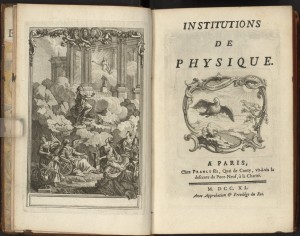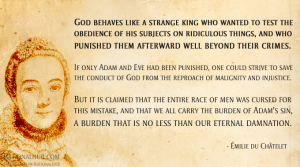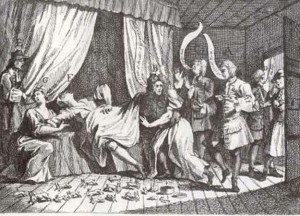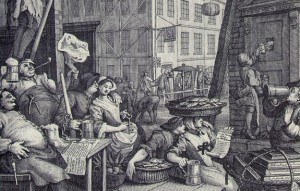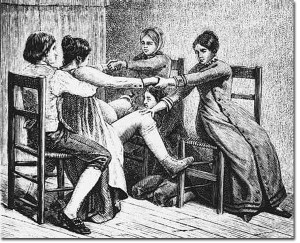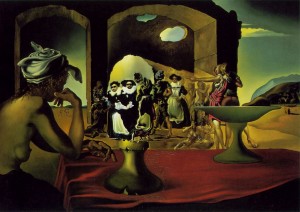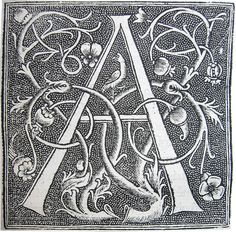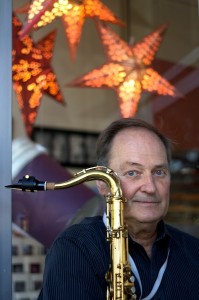The Jews
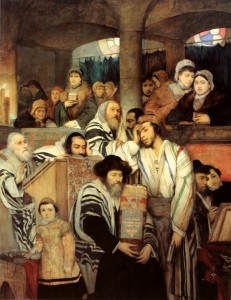
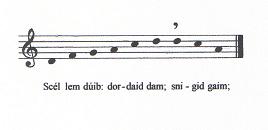
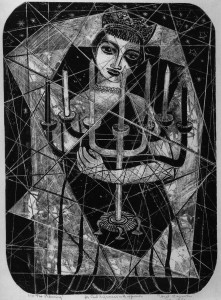
A tough people whose soul has been forged in some very trying times.

S’iz shver tsu zayn a Yid It’s tough to be a Jew. Yiddish saying Liev Schreiber

Schwer zu sein ein yid. Ben Brafman

Shvertz azayan Yid. Issur Danielovich

I should admit right away that I am an outsider, an agnostic, a nonbeliever (apikoros, apikoyres) who was raised in a devout Roman Catholic family. I try to be as good a person as I can and to treat everyone the way I would want them to treat me. This Golden Rule is, of course, the basis of many religions, creeds and beliefs.
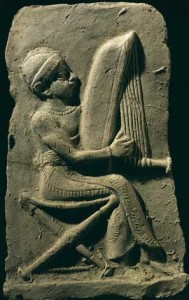
One of the things I always liked about Judaism ( יהודה, יהדו Yehudah, Judah in Hebrew, Greek Ἰουδαϊσμός) is that it is a nonproselytizing religion, like Buddhism.
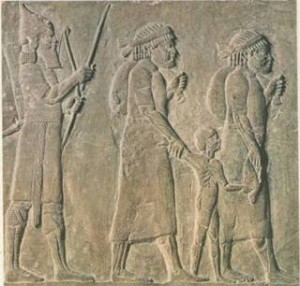
Conversion has been discouraged since the time of the Talmud, but today most forms of Judaism will accept sincere converts. It’s just that they don’t seek converts.

The first recorded mention of the Jews is in the Mernepteh stele.
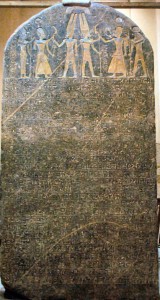
The story begins with Abraham (אַבְרָהָם) Avraham Avinu (אברהם אבינו), “our father Abraham.” He is seen as both the biological progenitor of the Jews (including converts, according to Jewish tradition), and the father of Judaism. Abraham is the first Jew.

According to the Tanakh, God promised Abraham to make of his offspring a great nation.

The Tanakh ( תַּנַ”ך) or Miqra is the canon of the Hebrew bible.
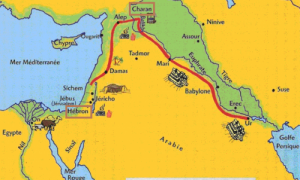
The Torah tells us that Jews are descended from the ancient people of Israel who settled in the land of Canaan between the eastern coast of the Mediterranean and the Jordan river.
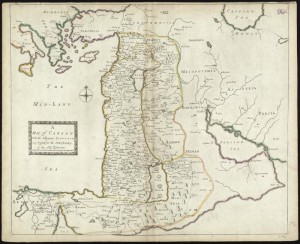
The children of Israel are described as descendants of common ancestors, including Abraham, his son Isaac, and Isaac’s son Jacob.
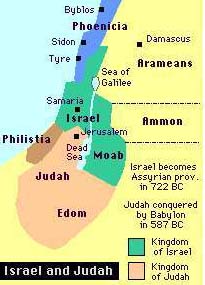
The nomadic travels of the Hebrews centered around Hebron in the first centuries of the second millennium BCE, apparently leading to the establishment of the Cave of the Patriarchs as their burial site in Hebron.
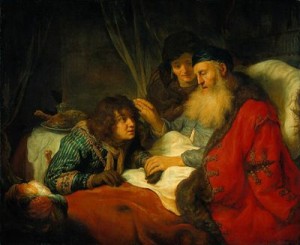
The Children of Israel consisted of twelve tribes, each descended from one of Jacob’s twelve sons, Reuven, Shimon, Levi, Yehuda, Yissacher, Zevulun, Dan, Gad, Naftali, Asher, Yosef and Benyamin.
Egyptian statue of a Semitic slave
Religious texts tell the story of Jacob and his twelve sons, who left Canaan during a severe famine and settled in Goshen (אֶרֶץ גֹּשֶׁן or ארץ גושן Eretz Gošen), northern Egypt.

The descendants of the twelve sons of Jacob were said to be enslaved by Pharaoh, although there is no independent evidence of this.
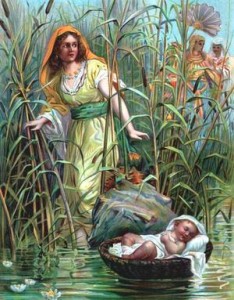
After they had been enslaved 400 years, YHWH sent Moses of the tribe of Levi to release the Israelites from bondage.
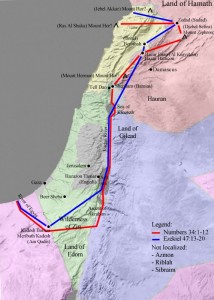
Then the Hebrews miraculously emigrated from Egypt (an event known as the Exodus), and returned to their ancestral homeland in Canaan. This event marks the formation of Israel as a political nation in Canaan, in 1400 BCE.
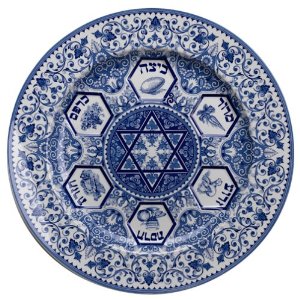
The science of archaeology tells a different story of the origins of the Jewish people. They did not necessarily leave the Levant.
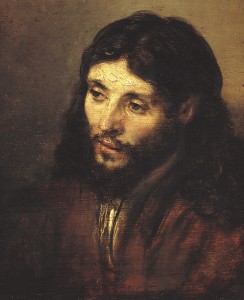
By the way, the Levant, also known as the eastern Mediterranean consists of Cyprus, Israel, Jordan, Lebanon, Palestine, Syria and a bit of southern Turkey. The first recorded name for this region was Canaan.
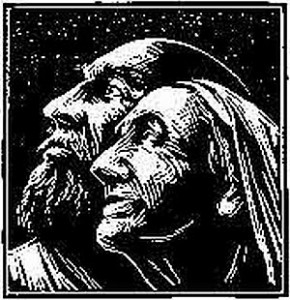
Levant means rising or lifting and it refers to the rising sun, so it originally meant the east in general. French levant, from Latin levare.
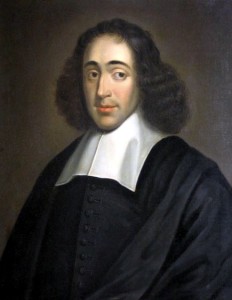
Similar etymologies are found in Greek Ἀνατολή (Anatolia), in German Morgenland (morning land), and in Hebrew (mizrah). Oriens meaning “east”, is literally “rising”, from Latin orior “rise”.
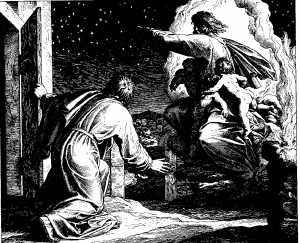
The archaeological evidence of the largely indigenous origins of Israel in Canaan, not Egypt, is quite convincing and there is no evidence of an Exodus from Egypt or a forty year pilgrimage through the Sinai wilderness.
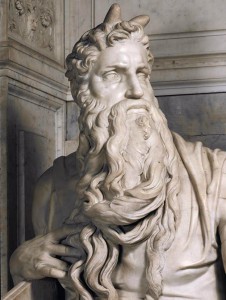
Many archaeologists view the archaeological investigation of Moses and the Exodus as a bootless quest.

A century of research by archaeologists has found no evidence that can be directly related to the Exodus narrative of an Egyptian captivity, escape and travels through a wilderness. That doesn’t mean that it didn’t happen, but just that there is no evidence for it.
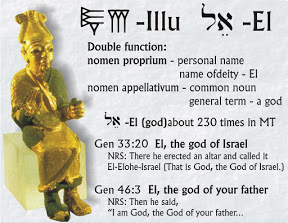
The culture of the earliest Israelite settlements is Canaanite, their cult-objects are those of the Canaanite god El, the pottery remains in the local Canaanite tradition, and the alphabet is early Canaanite.
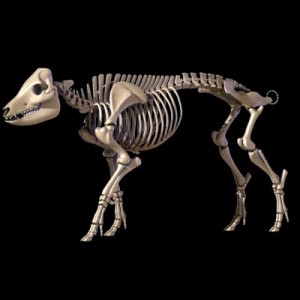
Almost the sole marker distinguishing the “Israelite” villages from Canaanite sites is an absence of pig bones at Israelite villages.

According to the sacred writings, after their emancipation from Egyptian slavery, the people of Israel wandered around and lived in the Sinai desert for a span of forty years before conquering Canaan in 1400 BCE under the command of Joshua.
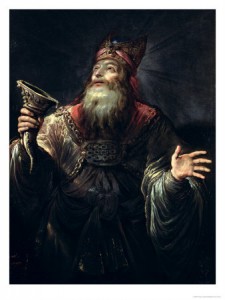
For several hundred years, the land in Israel was organized into a confederacy of twelve tribes ruled by a series of Judges.

After the last judge, Samuel, the writings say, came the kings of Israel.
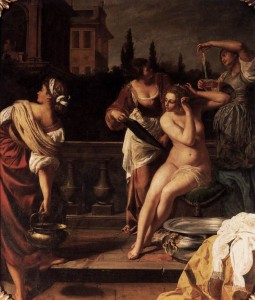
In 1000 BCE, the monarchy was established under Saul, and continued under King David and then his son, Solomon.
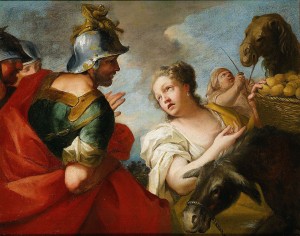
During the reign of David, Jerusalem became the national and spiritual capital of Israel.
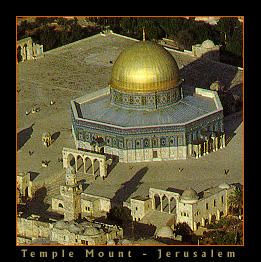
Solomon built the First Temple on Mount Moriah in Jerusalem, but the tribes were already fracturing politically.
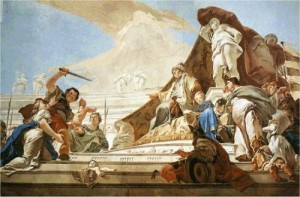
At Solomon’s death, a civil war erupted between the ten northern Israelite tribes, and the tribes of Judah and Benjamin in the south.
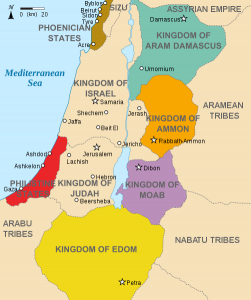
The nation split into Israel in the north, and Judah in the south.
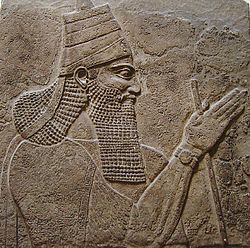
Israel was conquered by the Assyrian king Tiglath-Pileser III in the 8th century BCE. There is no commonly accepted historical record of the fate of the ten northern tribes, sometimes referred to as the Ten Lost Tribes of Israel, although speculation abounds.
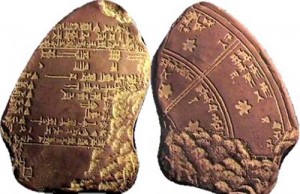
Judah was conquered by the Babylonian army in 587 BCE and the First Temple was destroyed. The elite of the kingdom and many of their people were exiled to Babylon, where the religion developed outside their traditional temple.

After the fall of Jerusalem, Babylonia (modern day Iraq) would become the focus of Judaism for more than a thousand years. The first Jewish communities in Babylonia started with the exile of the tribe of Judah to Babylon by Jehoiachin in 597 BCE.
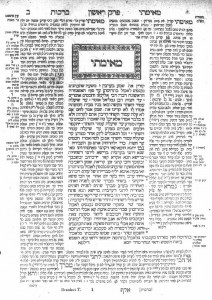
Babylonia became the center of Jewish life all the way up to the 13th century. It was there that the Babylonian Talmud was written in the languages used by the Jews of ancient Babylonia – Hebrew and Aramaic.
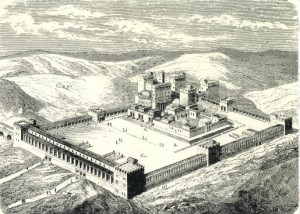
Many Jews returned to Jerusalem and with Persian approval and financing completed the Second Temple in 516 BCE.

The balance of power was shifting in the eastern Mediterranean to classical civilizations, and away from the Egyptians, Syrians, and Persians. Some Canaanites had already become Phoenicians and had colonized areas of the southern Mediterranean. Also, Greeks were beginning to probe eastwards.
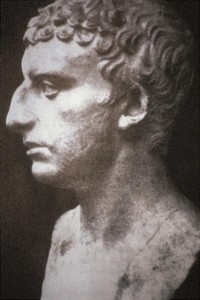
The Pharisees and Saducees were formed at this time. Josephus claimed that Pharisees received the backing and goodwill of the people in contrast to the more elite Sadducees.

Pharisees claimed Mosaic authority for their interpretation of Jewish laws, while Sadducees represented the authority of the priestly privileges established since the days of Solomon.
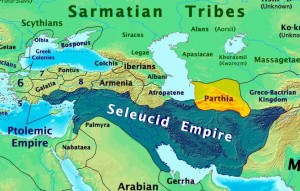
In 332 BCE, the Seleucid Kingdom was formed after the death of Alexander the Great and the division of his empire among his generals. This, of course, spread the Greek civilization to the east.
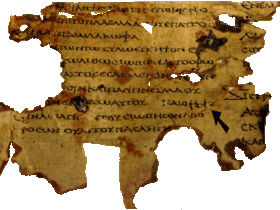
During this time, with the Jewish diaspora in Alexandria, Jewish thought was influenced by Hellenistic philosophy, culminating in the Septuagint, a translation of the Hebrew Bible and some related texts into Koine Greek by seventy (Latin: septuaginta, seventy) scholars.
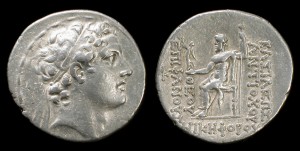
Antiochus IV, the Seleucid king, banned certain Jewish rites because of the deterioration of relations between hellenized Jews and orthodox Jews, causing the orthodox Jews to revolt under the leadership of the Hasmonean family (the Maccabees) which led to the formation of the Hasmonean Dynasty.
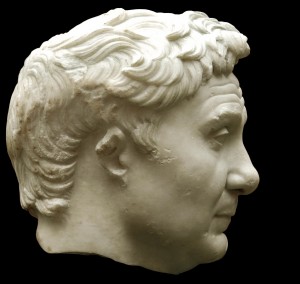
The people, who did not want to be governed by a king but by theocratic clergy, made appeals to the Roman authorities. Big mistake. A Roman campaign of conquest and annexation, led by Pompey, soon followed.
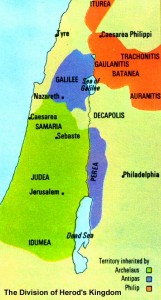
Pompey conquered Judea in 63 BCE, reorganized it as a client state, and appointed Herod the Great as king of the jews, thereby replacing the Hasmonean Dynasty with the Herodian dynasty.
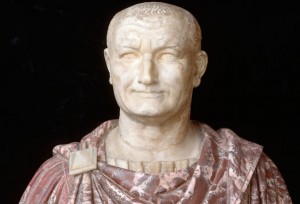
The empire was often callous and brutal in its treatment of its Jewish subjects and the Jews began to revolt against the Roman rulers of Judea. The revolt was defeated by the future Roman emperors Vespasian and Titus.
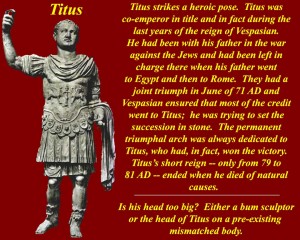
In 70 CE, the Romans destroyed much of the Temple in Jerusalem during the siege of Jerusalem.
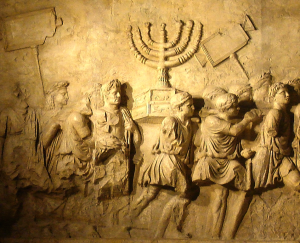
According to some accounts, the Romans plundered artifacts from the temple, such as the Menorah.
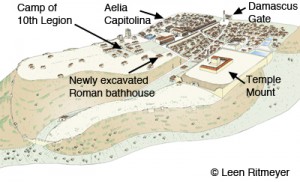
Banished from Jerusalem, the Jewish population now centered on Galilee. Jerusalem was renamed Aelia Capitolina and Judea was now called Syria Palestina to spite the Jews by naming it after their ancient enemies, the Philistines.
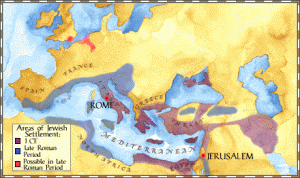
Many of the Judaean Jews were sold into slavery while others became citizens of other parts of the Roman Empire, but many, many Jews dispersed (διασπορά) throughout the known world. The policy encouraging prosyletism and conversion to Judaism, which spread the Jewish religion throughout the Helenistic civilization, seems to have subsided with the wars against the Romans.

Some of the most famous and important Jewish texts were composed in Israel at this time.
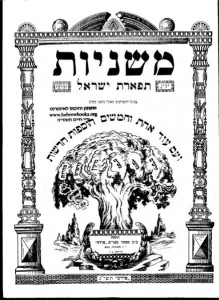
The completion of the Mishnah, the system of niqqud (dots representing vowels in Hebrew script), and the compilation of the Jerusalem Talmud are examples of this creative period.
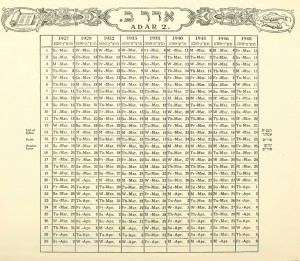
In 359 CE, Hillel II ( הלל נשיאה, Hillel the Nasi) created the Hebrew calendar based on the lunar year, which was necessary for the proper observance of the Jewish holy days.
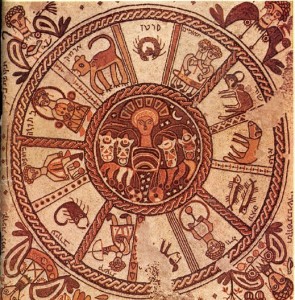
The 5th century of our era was a period when a wave of new synagogues were built, many with beautiful mosaic floors.
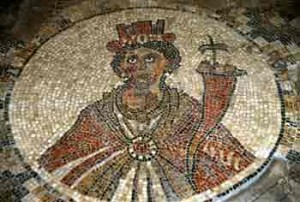
Jews adopted the rich art forms of the Byzantine culture. Jewish mosaics of the period portray people, animals, menorahs, zodiacs, and Biblical characters.
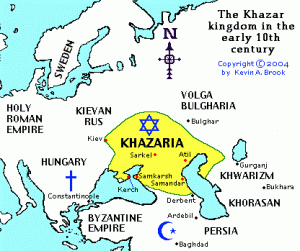
Sometime in the 7th or 8th century, the Khazars, a Turkic tribe (who dominated the vast area extending from the Volga-Don steppe lands to the eastern Crimea), seem to have converted to Judaism.
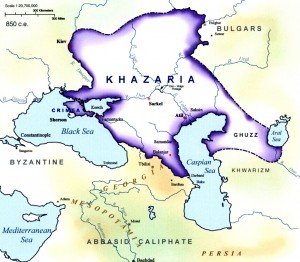
The completeness of this conversion is unclear.
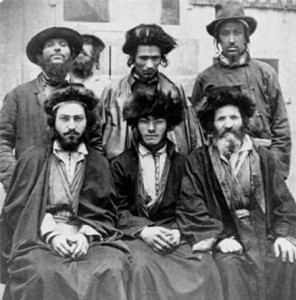
There had been a Jewish population in the Crimea since the Hellenistic era, and the conversions may have been reinforced by Jewish migrants entering the region, who had emigrated from areas of Byzantine rule.
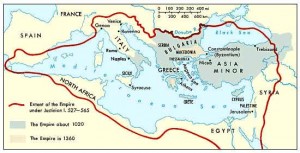
In 638 CE the Byzantine Empire lost control of the Levant.
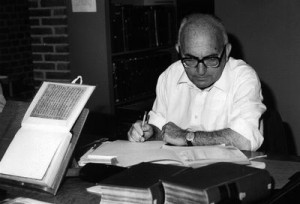
The Arab Islamic empire under Caliph Omar conquered Jerusalem and the rest of the Levant, but the Jews still controlled much of the commerce in Palestine. According to the Arab geographer Al-Muqaddasi, the Jews worked as “the assayers of coins, the dyers, the tanners and the bankers in the community”. Professor Moshe Gil documents that at the time of the Arab conquest in the 7th century CE, the majority of the population was Jewish.
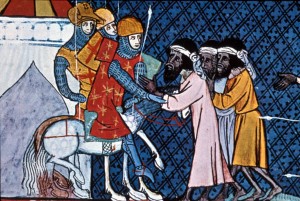
In 1099, Jews helped the Arabs to defend Jerusalem against the Crusaders. When the city fell, the Crusaders gathered many Jews in a synagogue and set it on fire.

Jews almost singlehandedly defended the town of Haifa against the Crusaders.
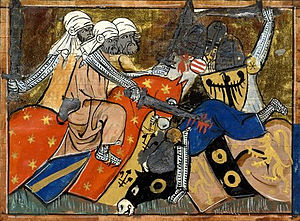
Jews were not allowed to hold land during the Crusader period, so they worked at trades and commerce in the coastal towns during times of peace.
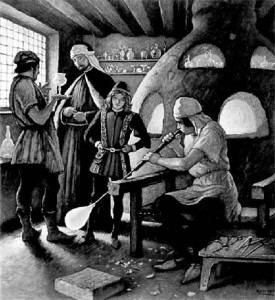
Most were artisans: glassblowers in Sidon, furriers and dyers in Jerusalem.

During this period, the Masoretes of Tiberias established the niqqud, a system of diacritical marks used to represent vowels.
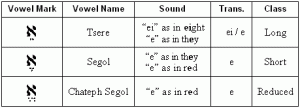
The niqqud (dots, dotting) distinguished between alternative pronunciations of letters of the Hebrew alphabet, which, like most Semitic scripts only used consonants.
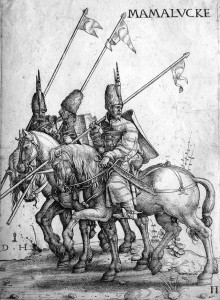
The Mamluks ( مملوك mamlūk (singular), مماليك mamālīk (plural), meaning “property” or “owned slave” of the king”) were proud of their origin as slaves and only those who were purchased were eligible to attain the highest positions. Finally, the Mamluks attained the sultanate of Egypt and an empire.
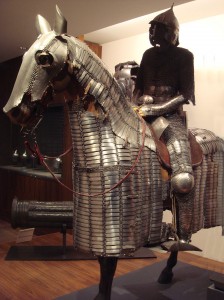
During the years 1260–1516, Israel was part of the Mamluks’ domain. Jews suffered persecution and humiliation under the Mamluks, but at least thirty Jewish urban and rural communities were flourishing by the beginning of the 16th century.

Jews were in Europe, especially in former Roman colonies, from very early times. As Jewish males had emigrated, they sometimes took wives from local populations, as is shown by MtDNA compared to Y-DNA among Jewish populations. Records of Jewish communities in France and Germany date from the 4th century, and substantial Jewish communities in Spain were noted even earlier.
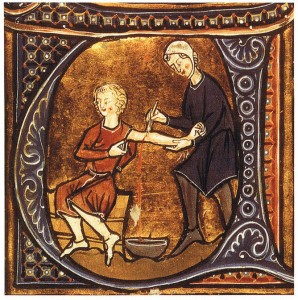
Norman Cantor and other 20th-century scholars dispute the tradition that the Middle Ages was a uniformly difficult time for Jews.
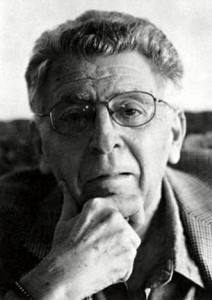
Medieval society was tolerant before the Catholic Church became powerful, stratified and rule bound.
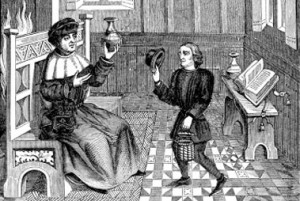
Between 800 and 1100, about 1.5 million Jews lived in Europe. They were not Christians, and thus they were not included as a part of the feudal system of clergy, knights and serfs, so they did not have to satisfy the oppressive demands for labor and military conscription that Christians suffered.
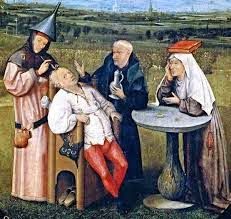
In relations with the Christian society, the Jews were protected by kings, princes and bishops, because of crucial services they provided in three areas: financial, administrative and medical.
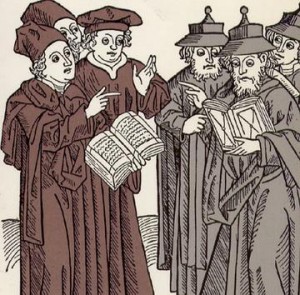
Christian scholars interested in the Bible consulted with Talmudic rabbis.
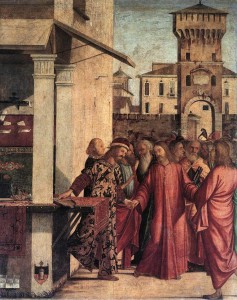
By 1300, however, the friars and local priests staged the Passion Plays during Holy Week, which depicted Jews (in contemporary dress) killing Christ. From this period, there was frequent persecution of Jews and the deportations began.
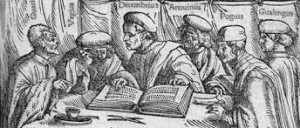
Around 1500, Jews found relative security and a renewal of prosperity in present-day Poland.
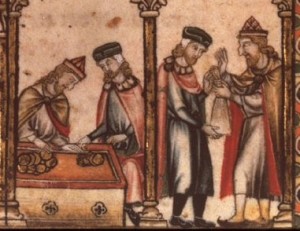
As Catholics were forbidden by the church to loan money for interest, some Jews became prominent moneylenders.
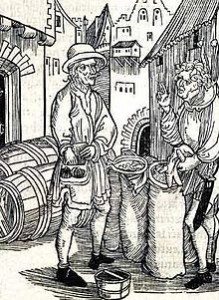
Christian rulers gradually saw the advantage of having such a class of people who could supply capital for their use without being liable to excommunication. As a result, the money trade of western Europe became a specialty of the Jews. But, in almost every instance when Jews acquired large amounts through banking transactions, during their lives or upon their deaths, the king would take it over.

Jews became servi cameræ, the property of the King, who might present them and their possessions to princes or cities.
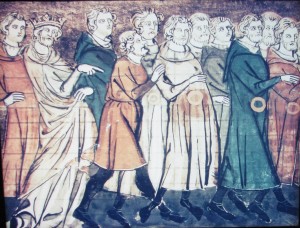
The Crusades were followed by massive expulsions, including (in 1290) the banishing of all English Jews; in 1396 100,000 Jews were expelled from France; and in 1421, thousands were expelled from Austria.
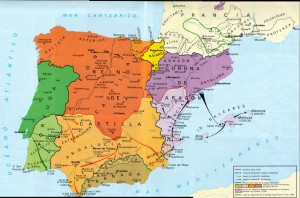
In 1492, after los reyes católicos, Ferdinand and Isabelle, had reconquered al-Andalus, as Moorish Spain was known, the worst of the expulsions of the Jews occurred.
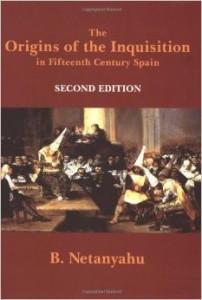
Benjamin Netanyahu is, of course, the present prime minister of Israel. His father wrote this book.
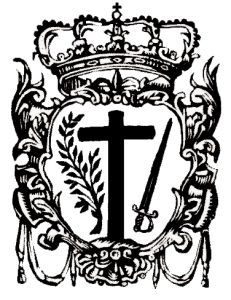
With the ejection of the last Muslim rulers from Granada, the Spanish Inquisition (Tribunal del Santo Oficio de la Inquisición) followed and around 200,000 Sephardic Jews were expelled.
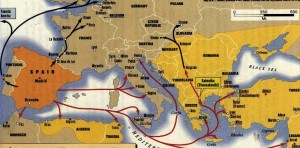
This was followed by expulsions in 1493 in Sicily (37,000 Jews) and Portugal in 1496. The expelled Spanish Jews fled mainly to the Ottoman Empire, Holland, and North Africa, others migrating to Southern Europe and the Middle East.

Jews in Spain were generally better treated by Islamic rulers than Christian ones.

Despite second-class citizenship, Jews played prominent roles in Muslim courts, and experienced a Golden Age in Moorish Spain about 900–1100, though the situation deteriorated after that time.
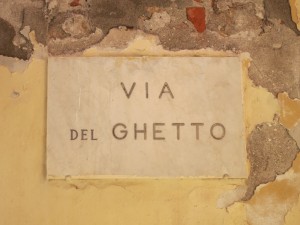
Riots resulting in the deaths of Jews did however occur in North Africa through the centuries and especially in Morocco, Libya and Algeria, where eventually Jews were forced to live in ghettos.

During the 11th century, Muslims in Spain conducted pogroms against the Jews, occurring in Córdoba in 1011 and in Granada in 1066.

During the Middle Ages, the governments of Egypt, Syria, Iraq and Yemen enacted decrees ordering the destruction of synagogues. At certain times, Jews were forced to convert to Islam or face death in some parts of Yemen, Morocco and Baghdad.
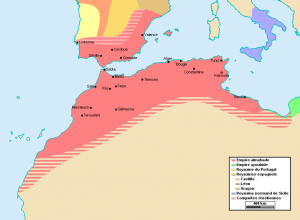
The Almohads had taken control of much of Islamic Iberia by 1172.
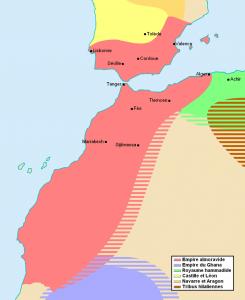
They surpassed the Almoravides in fundamentalist outlook, and treated the dhimmis harshly. Dhimmis are non-Muslim citizens of an Islamic state, be they Jewish or Christian.
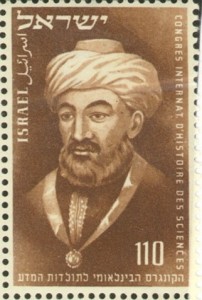
The Almohads expelled both Jews and Christians from Morocco and Islamic Spain. Faced with the choice of death or conversion, many Jews emigrated. Some, such as the family of Maimonides, fled south and east to the more tolerant Muslim lands, while others went northward to settle in the growing Christian kingdoms.
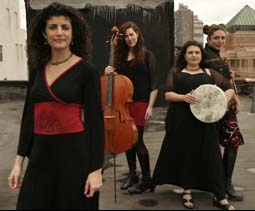
In the 2nd century CE, Spanish Jews gave the name Sepharad (סְפָרַד, Modern Sfarád Tiberian Səp̄āráḏ) to the Iberian peninsula.

Their descendants refer to themselves as Sephardi Jews (Hebrew, plural: Sephardim) and identify Spain as Sepharad in modern Hebrew. Hank Azaria

In Greek the Sephardi are called Σεφαρδίτες. David Levy
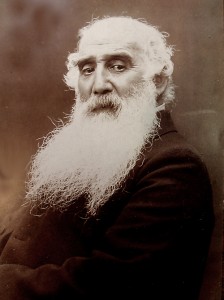
In the narrower ethnic definition, a Sephardi Jew is a Jew descended from the Jews who lived in the Iberian Peninsula in the late 15th century, immediately prior to the issuance of the Alhambra Decree of 1492 by order of los reyes católicos in Spain, and the decree of 1496 in Portugal by order of King Manuel I. Camille Pissaro

In Hebrew,the term Sephardim Tehorim (ספרדים טהורים, Pure Sephardim) is used to distinguish Sephardim proper “who trace their lineage back to the Iberian/Spanish population” from Sephardim in the broader religious sense. Émanuelle Béart

The broad religious definition of a Sephardi refers to any Jew, of any ethnic background, who follows the customs and traditions of Sepharad. Peter Sellers
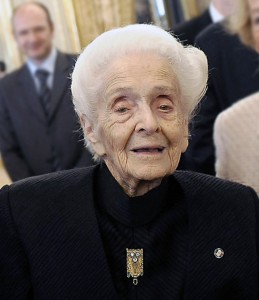
In modern Israel, Sephardim is most often used to encompass most non-Ashkenazi Jews who are not ethnically Sephardi, but are in most instances of West Asian origin, but who use a Sephardic style of liturgy. Rita Levi Montalcini
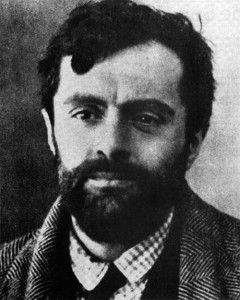
Ethiopian Jews, whose branch of practiced Judaism is known as Haymanot, have recently come under the already broad umbrella of Israel’s Sephardic Chief Rabbi. Amedeo Modigliani
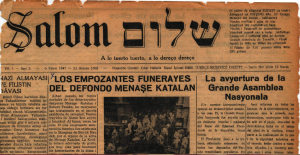
Their traditional language is referred to as Judezmo (Jewish, Judaism), it is the Judeo-Spanish sometimes also known as Ladino.
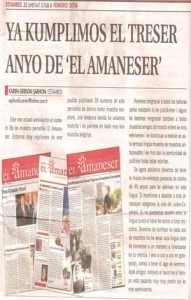
If you understand Spanish, you can probably understand the Sephardic Judaeo-Spanish (Ladino, Judezmo), just as if you understand German, you can probably understand Yiddish. The headline above says: Now we have completed the third year of ‘El Amaneser’ (The Dawn).

Judeo-Spanish (Ladino, Judezmo)
El djudeo-espanyol, djudio, djudezmo es la lingua favlada por los djudios sefardim ekspulsados de la Espanya en el 1492. Es una lingua derivada del espanyol i favlada por 150.000 personas en komunitas en Israel, la Turkia, antika Yugoslavia, la Gresia, el Maruekos, Mayorka, las Amerikas, entre munchos otros.

Spanish
El judeo-español, djudio, djudezmo o ladino es la lengua hablada por los judíos sefardíes expulsados de España en 1492. Es una lengua derivada del español y hablada por 150.000 personas en comunidades en Israel, Turquía, la antigua Yugoslavia, Grecia, Marruecos, Mallorca, las Américas, entre muchos otros.

Judeo-español is usually written in the Hebrew alphabet and can look like this.
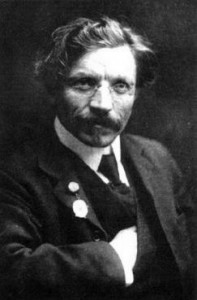
Yiddish (German: Jüdische Jewish) is a dialect of old German that is written in the Hebrew alphabet, so there are many, many variant spellings when the language is transcribed into the Roman alphabet that we use. Also there are variations from country to country and even from family to family, so I guarantee that there are going to be many people who read below and say, “Oh, that’s not how that’s spelled,” or “We say that differently,” or, “That’s not what that means.” Please, read with some indulgence.
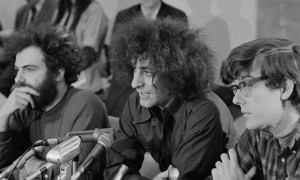
A shande fur die goy. A shame in front of the goyim. This is what Abbie Hoffman said to Judge Julius Hoffman in the trial of the Chicago Seven.

A shlekhter sholem iz beser vi a guter krig. A bad peace is better than a good war.

Abi gezunt ! אַבי געזונט As long as you’re healthy. (sometimes said ironically) Mel Brooks said this to Cleavon Little in Blazing Saddles. The goyim thought he was speaking Apache, but, no, it was Yiddish.
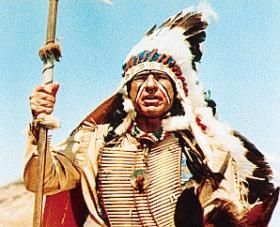
The Vanishing American Yiddish Speaker. Abi gezunt!

My friend George Michalski claims to be the world’s youngest Yiddish speaker. I mentioned this to someone and she said, “There are thirteen, fourteen year old girls who lie on the sand in Miami Beach speaking fluent Yiddish to each other.”
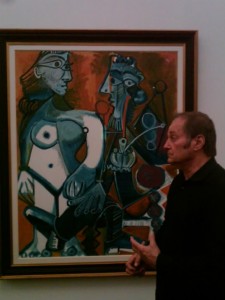
Alter Cocker: An old, complaining person, an old fart, an alter kocker.

A maidel mit a klaidel. A girl with a dress. Cutie-pie got a new dress! kleyd קלייד dress
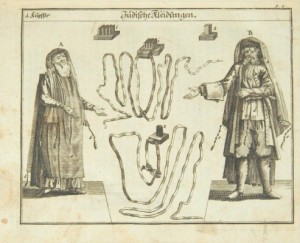
German Kleidung clothing

Bei mir bist du shayn. To me you are beautiful. German schön
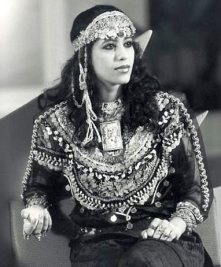
Berye, berryer בריה a skillful person, especially one who keeps house well

Bisl, bissel, a bissel, a bisele ביסל a bit of something, a little bit German ein bißchen
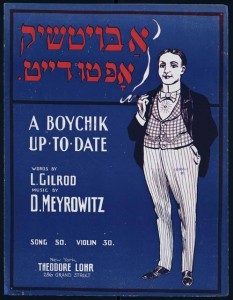
Boytshik, boychik בויטשיק young boy (American Jewish)
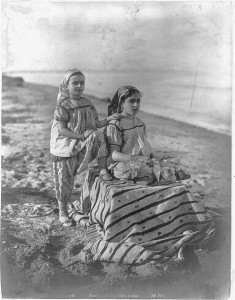
Brokhe, broche ברכה a prayer
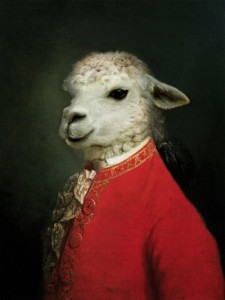
Bube, bubeleh בובי bubby, a term for someone you like (American Jewish)

Such a sheine punim, kenahora. Such a pretty face, keep evil away from her. Kenahora is difficult to translate.
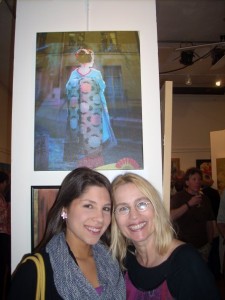
People, even some Jews, think kenahora is a jinx. It’s actually the opposite of a jinx. It’s the warding off of a jinx. It’s saying “No evil eye.”

This phrase has so many spellings and so many meanings. In the Bronx they say No canary. Sometimes it’s spelled kinahorra.
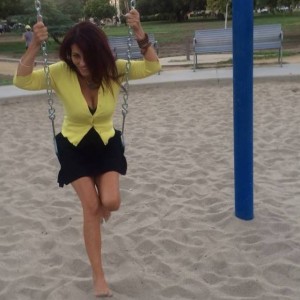
The phrase can be pronounced either “Bli Ayin Hara” in Hebrew, or “Kein Ayin Hora” in Yiddish. Both expressions translate as, “without the evil eye” or “there should be no evil eye.” When it’s said quickly is can sometimes sound like “Kina Hora.”

When people talk about their or others’ gains, assets or blessings, they often say “kein ayin hora” to ward off any envy, any negative thoughts, any evil that may be lurking anywhere, anyhow in the universe. There’s a similar phrase in English, but I can’t think of it right now. Maybe Knock on wood?

“Bless her heart” comes close but it often has the opposite effect. In the South, if you hear someone say, “Now, Jenny, bless her heart…” you know that what follows is not going to be so good. The speaker is pardoning Jenny, but really cursing her at the same time. This sentence completed could be something like, “Now, Jenny, bless her heart, is not one of the deepest puddles in the parking lot.” There is something of a Kein ayin hora feeling here, but not really, know what I mean?
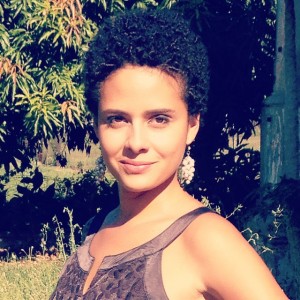
The classical word for this warding off of evil is apotropaic. Apotropaic magic is intended to “turn away” harm or evil influences, as in deflecting misfortune or averting the evil eye. The Greeks made offerings to the Averting Gods, (Ἀποτρόπαιοι θεοί), chthonic deities who grant safety and deflect evil.
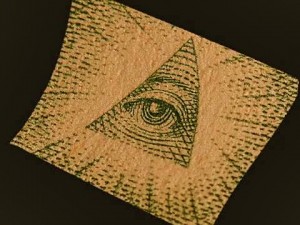
The Yiddish expression, Kain ein horeh (קיין עין הרע) is apotropaic in nature, and literally translates to no evil eye.
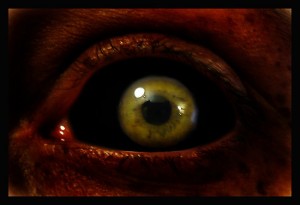
Eyn-ore עין־הרע Evil Eye, a power that can cause injury

Keyn eyn-hore zol im nit oysmaydn! קיין עין–הרע זאָל אים ניט אויסמײַדן! Let no evil eye avoid him!

Farbissener bitter
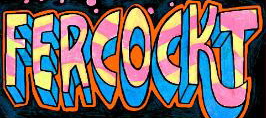

Farkakt, fercockt פֿאַרקאַקט lousy, screwed up, washed up, shitty, crappy, full of shit, fucked

Farklemt, verklempt פֿאַרקלעמט choked up, extremely emotional, distraught, depressed, on the verge of tears

Gam-atem. גם־אַתּם Same to you. Likewise.

Garmoshke גאַרמאָשקע harmonica Larry Adler
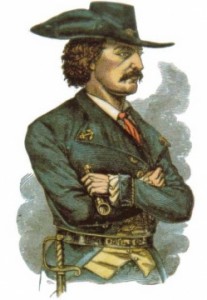
Gazlen גזלן robber, thief Jean Lafitte, the pirate, was a Sephardic Jew.

Geboyrner reder געבוירנער רעדער a born (Yiddish) speaker
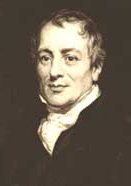
Gelt געלט money David Ricardo, the economist, was a Sephardic Jew.
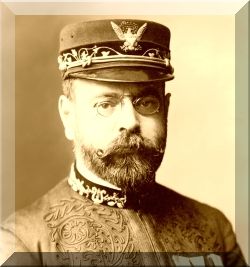
Grepse Blech a burp, a belch

Hak mir nisht keyn tshaynik! האַק מיר נישט קיין טשײַניק Stop talking nonsense!

Haymish informal, friendly A haimisher mensch is someone you feel comfortable with. German heimisch

Hor האָר hair German Haar Vidal Sassoon was a Sephardic Jew.

Ikh vais. I know. Ich weiss. (German)

Kalifornye קאַליפֿאָרניע California
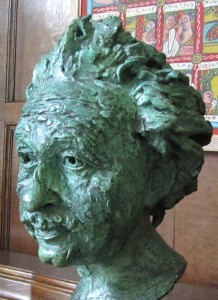
Kop קאָפּ head German Kopf

Krasavitse קראַסאַוויצע beautiful woman, une belle
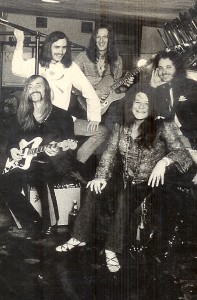
Lakhn biz trern לאַכן ביז טרערן laugh till you cry
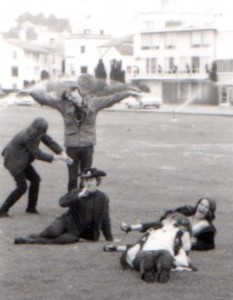
Lakhn mit yashtsherkes לאַכן מיט יאַשטשערקעס laughing through tears

Langer loksh לאַנגער לאָקש tall, thin person

Libe ליבע love, love affair, romance German Liebe
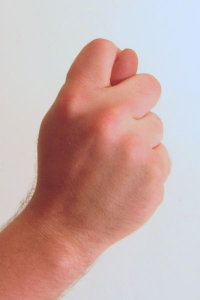
Makhn a fayg. מאַכן אַ פֿײַ derision, meaning that nothing will come out of one’s efforts Italians call this il manofico, the hand fig, and in Dante the devil makes this gesture to god, meaning Fuck you.

Mame-loshn, mama loshen מאַמע־לשון mother tongue

Maven, meyven מבֿין an expert, a connoisseur, or, in this case, a connoisseuse Barbara Tuchman

Meshuge, meshugge משוגע crazy

Nakhes נחת pleasure, especially the pleasure that a parent gets from a child
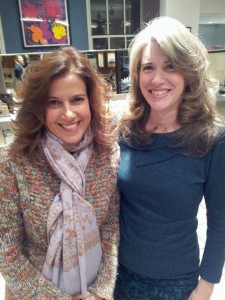
Oysergeveyn(t)lekh אויסערגעוויינ(ט)לעך outstanding, extraordinary, exceptional
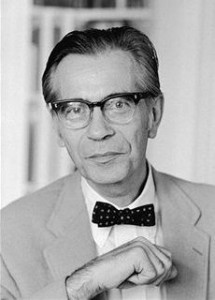
Onshtendik אָנשטענדיק decent, honorable

Pirog פּיראָג meat pie, vagina (vulgar, obviously)

PLOTZ, Plats: פּלאַץ To burst, to explode, to crack, split, I can’t laugh anymore or I’ll plotz.

PUTZ: A vulgarism for penis but most usually used as term of contempt for a fool, or an easy mark.

Red tsu mir yidish. רעד צו מיר ייִדיש Speak Yiddish with me. Simon Schama

Sara groyse oygn! What! Wow! (admiration, surprise) big eyes Sarah Silverman is a Sephardic Jew, but she probably knows her share of Yiddish.

Sheyn שיין beautiful, pretty, lovely, nice Susan Zelinsky

Shayneh kepeleh pretty head good looking good thoughts
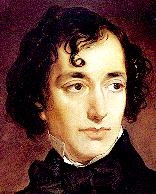
Sheferish שעפֿעריש or שאפֿעריש creative or Shaferish German schöpferisch Benjamin Disraeli was a Sephardic Jew.

Shmek שמעק sniff, whiff When Albert Grossman told us that he didn’t want any heroin use in the band, this is the word he used. We all knew what he meant immediately. German schmecken taste

Shmok, Schmuck שמאָק jerk, fool, idiot, contemptible person, naïve person, penis, dick, asshole
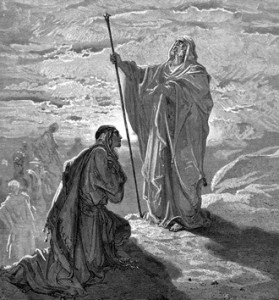
Shmuel שמואל Samuel
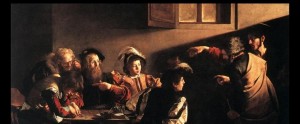
Shtayer-moner tax collector
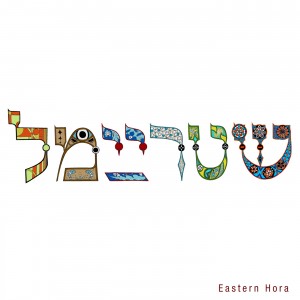
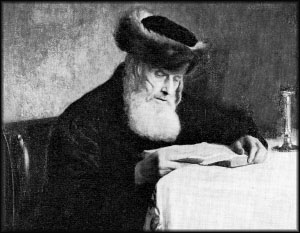
Shtrayml, shtreimel שטרײַמל a fur edged hat worn by rabbis and Hasidic Jews on the Sabbath and holidays

Tants טאַנץ dance

TSIMMES, Tzimmes: A side dish with many ingredients and complicated cooking instructions, a prolonged procedure, an involved and troubling business, as in the phrase, “don’t make a tsimmes out of it.”
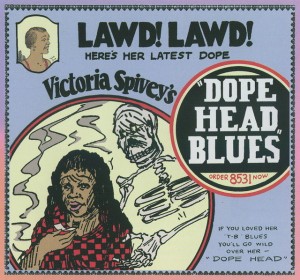
Tsuris, TSORISS: Suffering, woes, blues

Umfarshemt אומפֿאַרשעמט shameless, impudent The Spanish for this is Sin vergüenza.

Untergebn kheyshek אונטערגעבן חשק encourage

Vebadres וועבאַדרעס web adress, URL
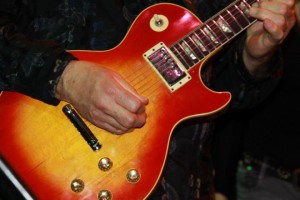
Vegetariar וועגעטאַריער vegetarian

Velt וועלט world German Weld the planet Mercury

Ven meshiakh vet kumen. When the Messiah will come.

Vild ווילד wild, savage, absurd a vilda chaya a wild child

VUS MACHS DA: What’s happening? What’s up? German Was machst du da? What are you doing there?
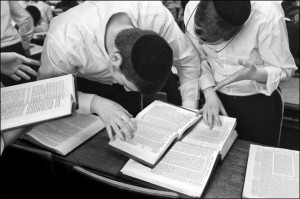
Yeshive ישיבֿה A Jewish school of high talmudic learning

Yitskhok, Itzak יצחק Isaac
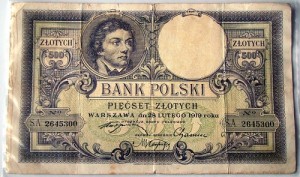
Zlote זלאָטעס Zloty (Polish currency)
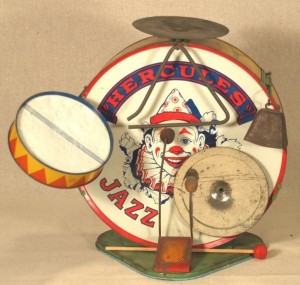
Zshlob, shlub זשלאָב boor, ill mannered, peasant, clumsy person
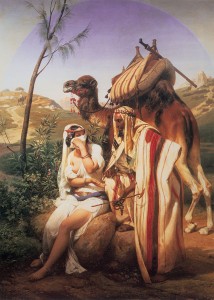
See you next week? Vayln zikh ווײַלן זיך Have a good time.
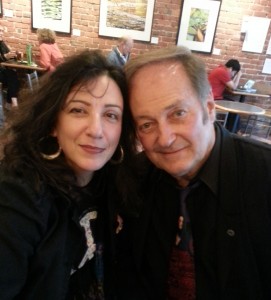
Mari Mack Sam Andrew

__________________________________________________
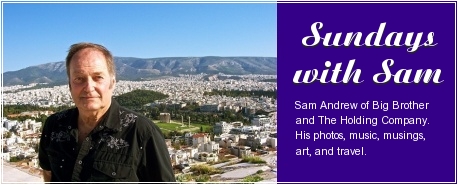










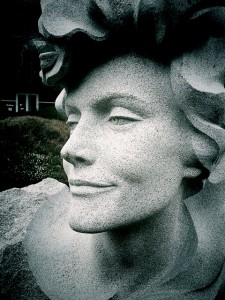







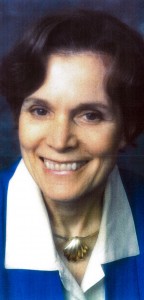








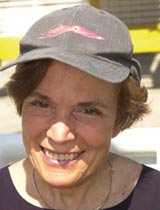
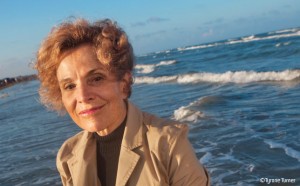






















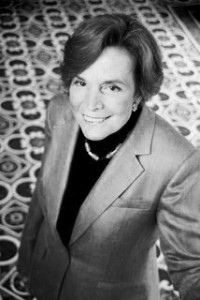







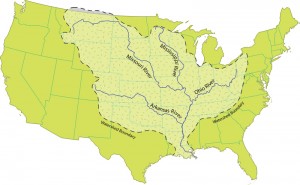







































































































































































































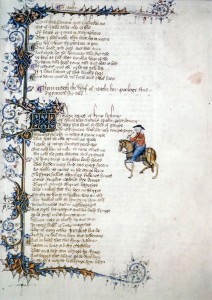

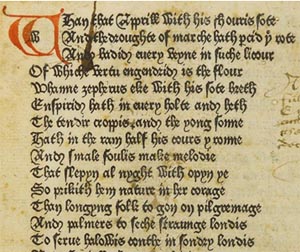
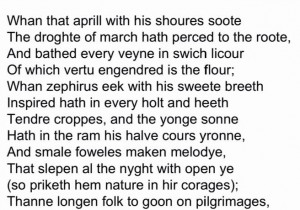



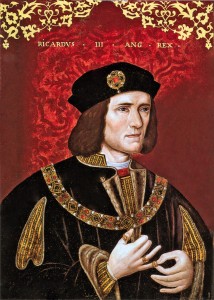

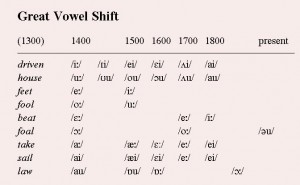
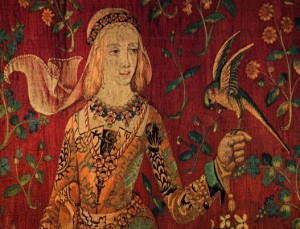


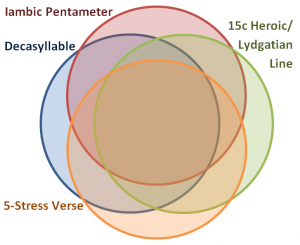


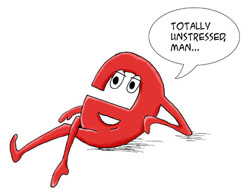

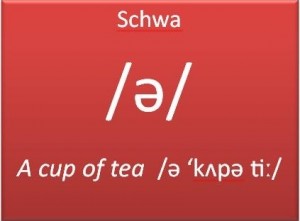

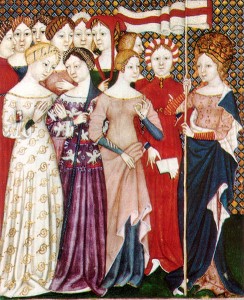
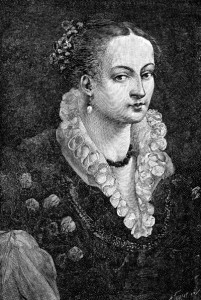
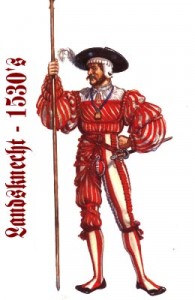
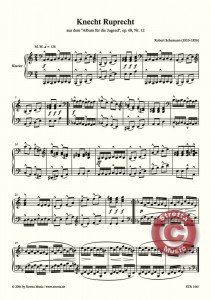
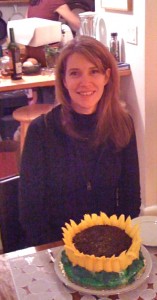
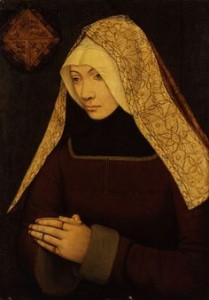
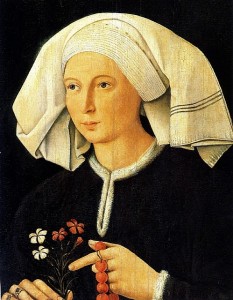
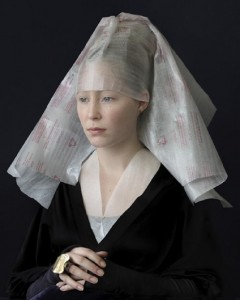
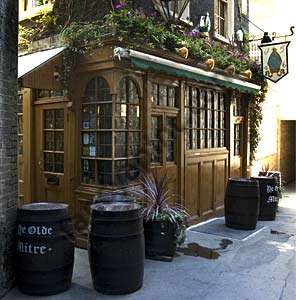
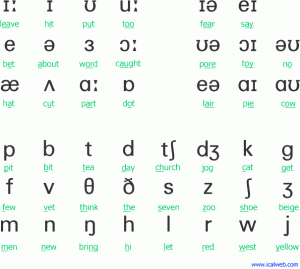
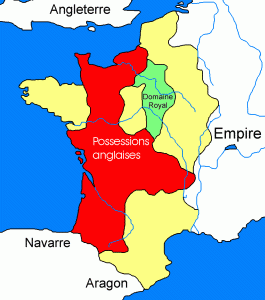



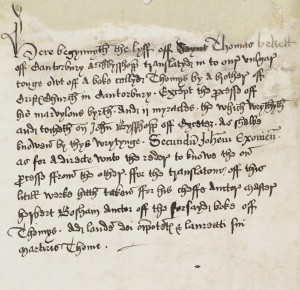

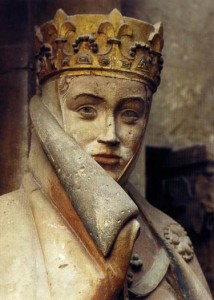
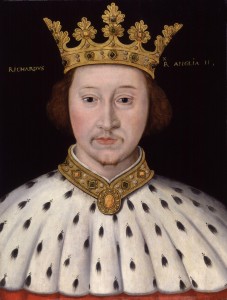



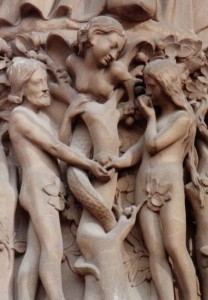
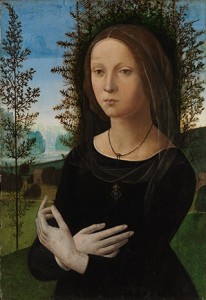
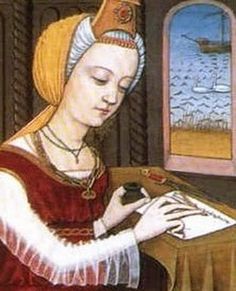

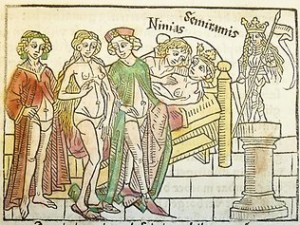
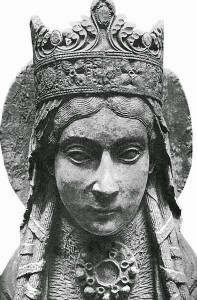
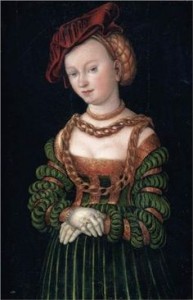
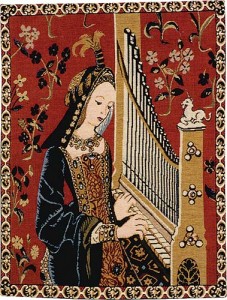
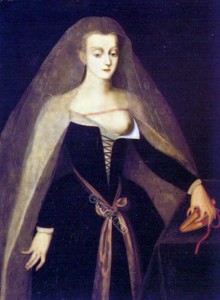
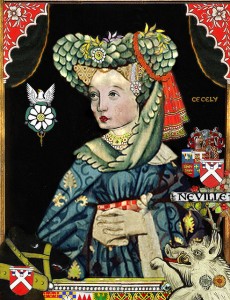
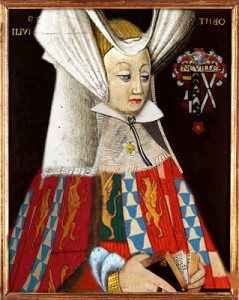
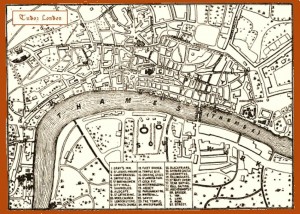

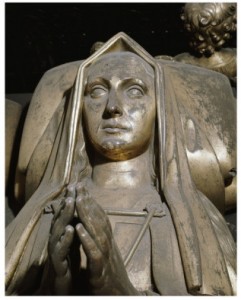


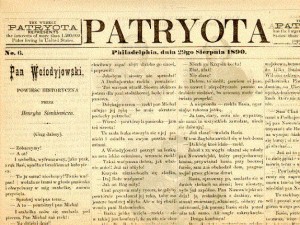
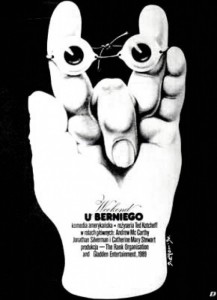
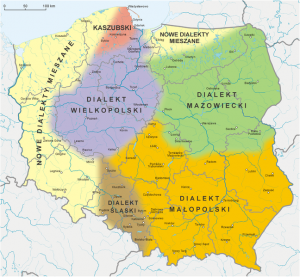
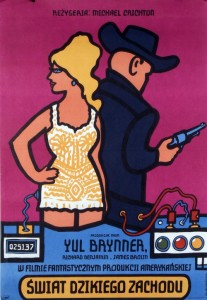
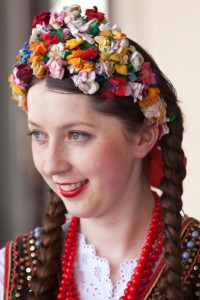
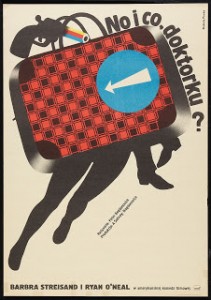
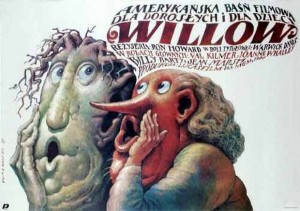
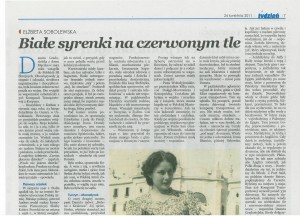
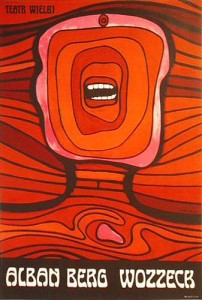

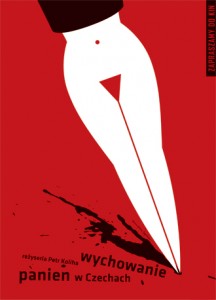
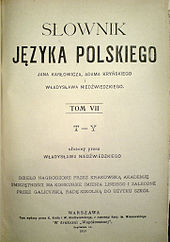
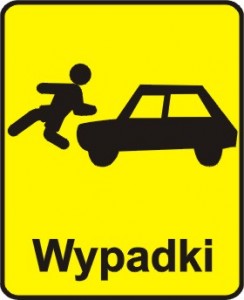



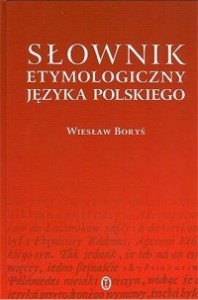
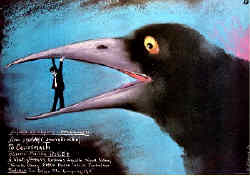

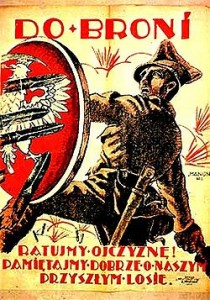

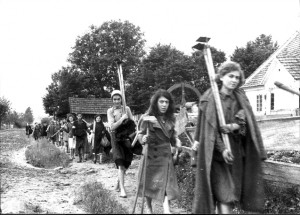
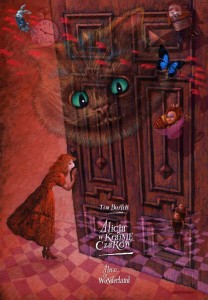
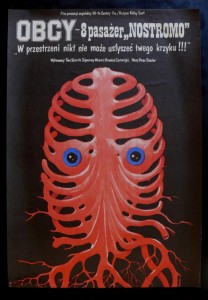

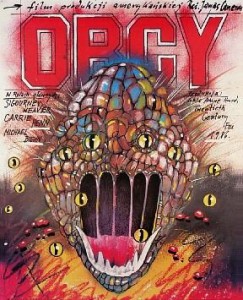


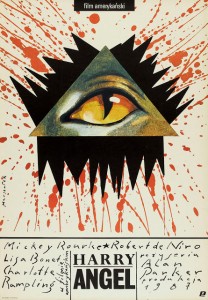
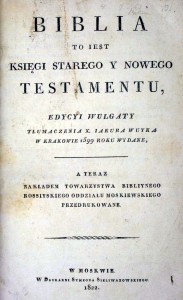
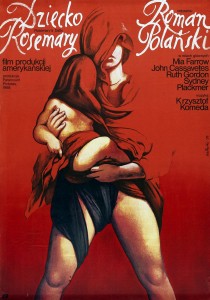

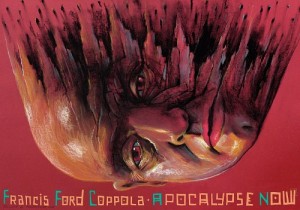
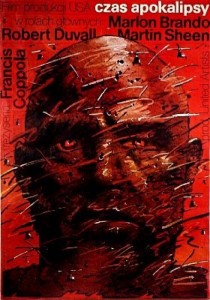
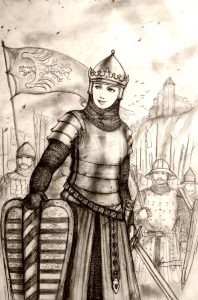
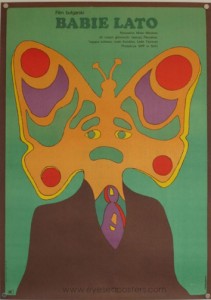
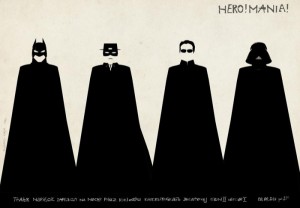
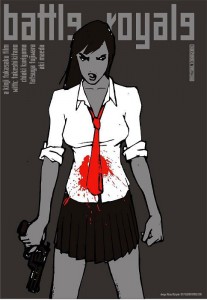
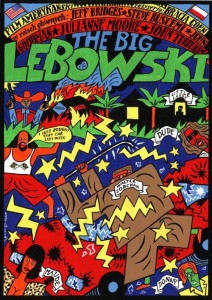
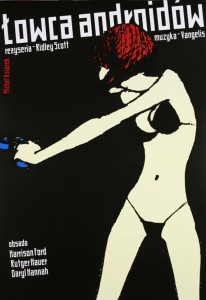


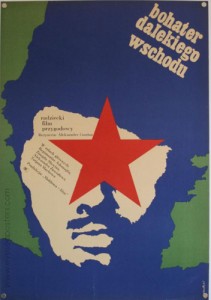

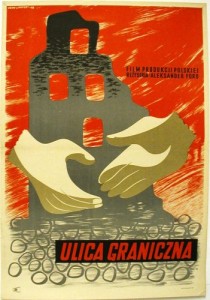

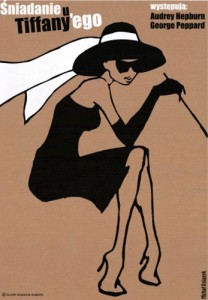
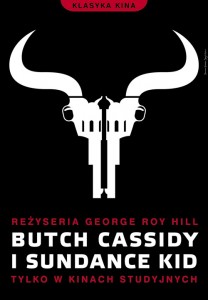
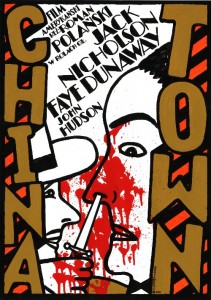
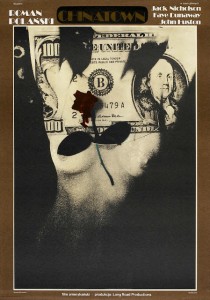
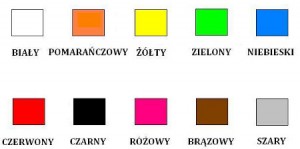
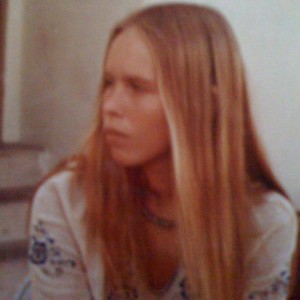
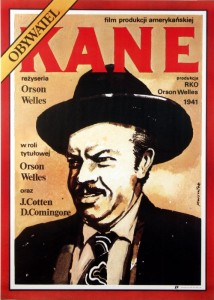
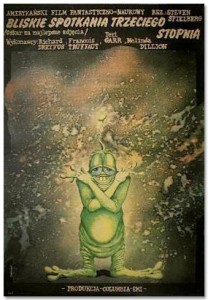
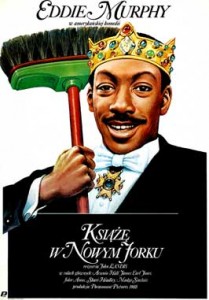
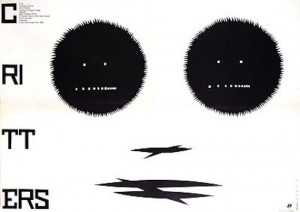

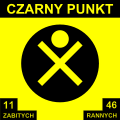

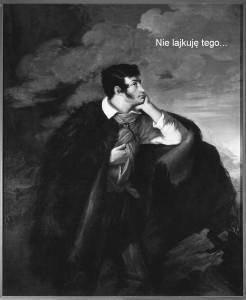
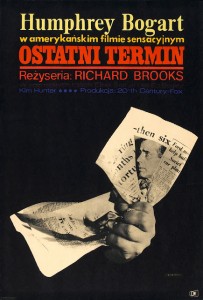


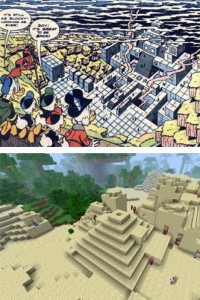

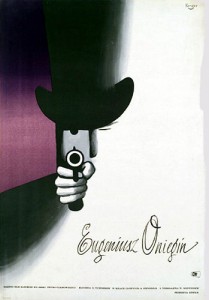
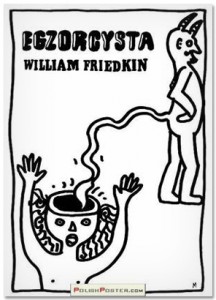
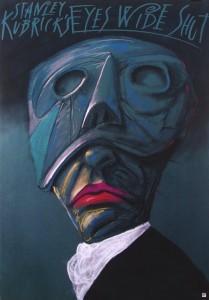
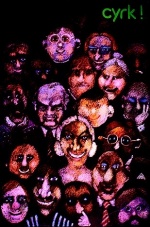
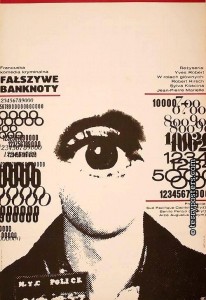
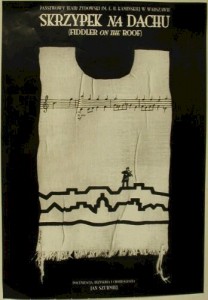
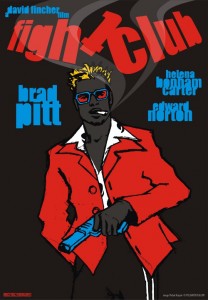
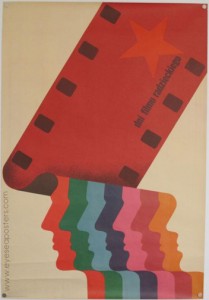
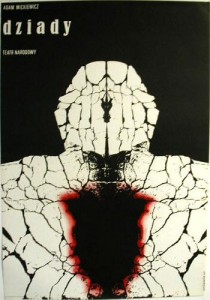

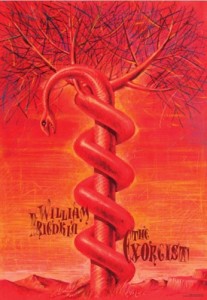
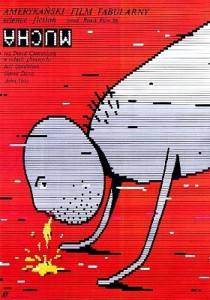




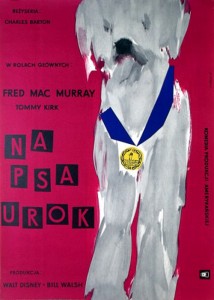
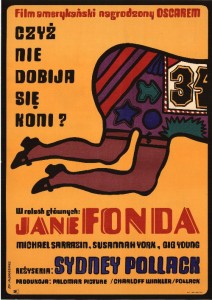
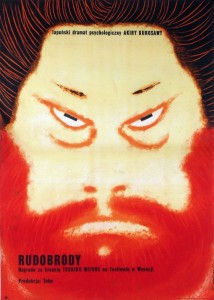

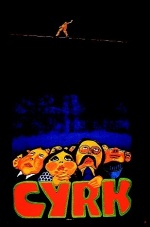


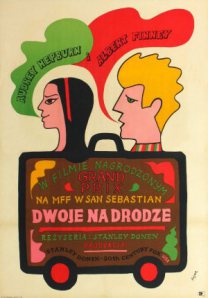


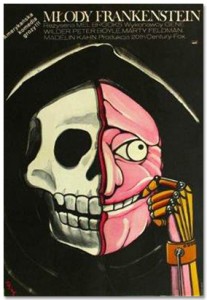


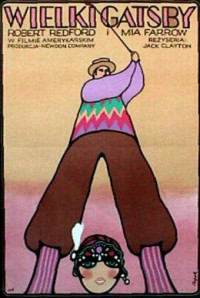
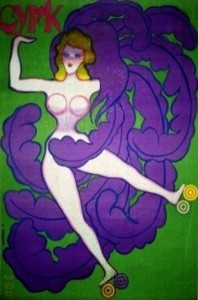
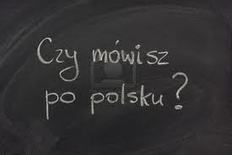
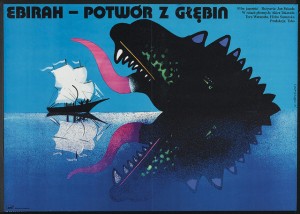
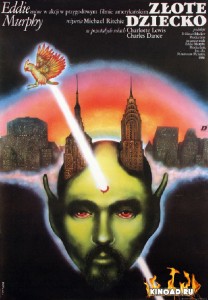
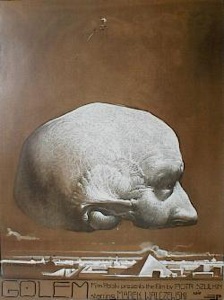

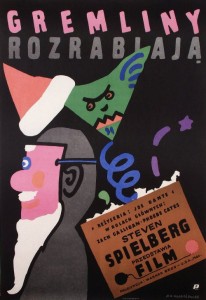
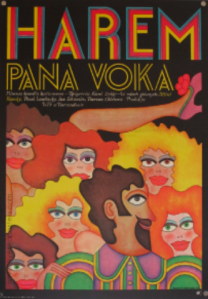

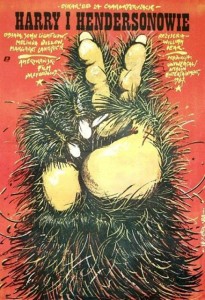
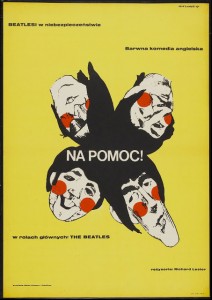
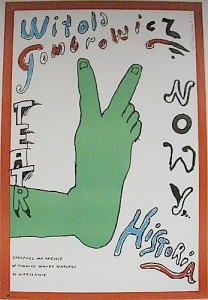







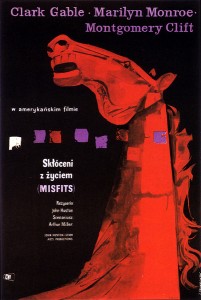



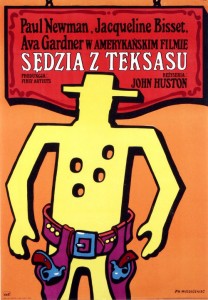
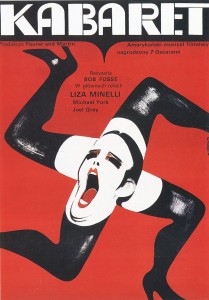
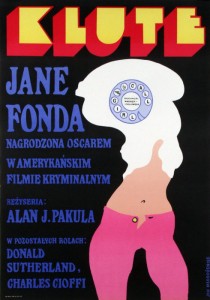

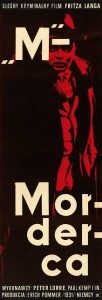

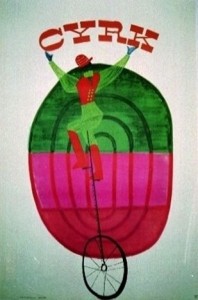


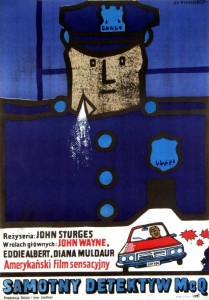
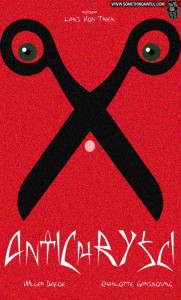
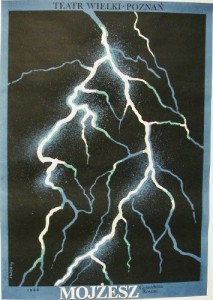

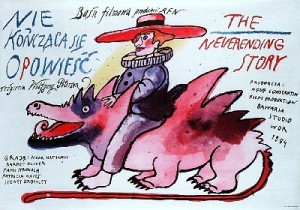
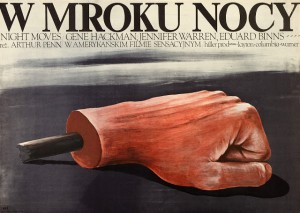
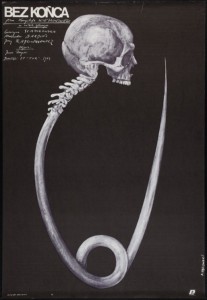


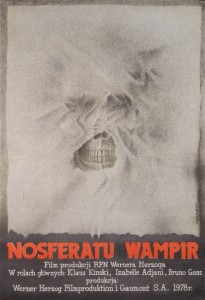
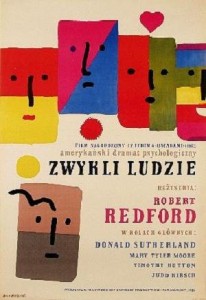
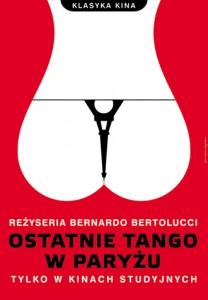



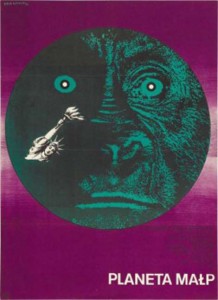
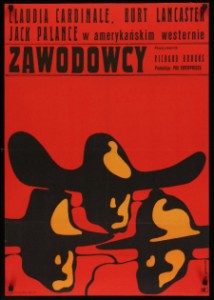
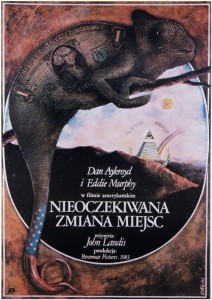
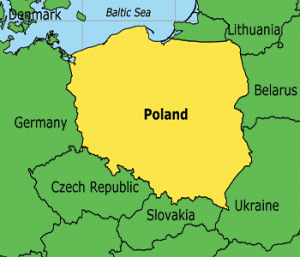
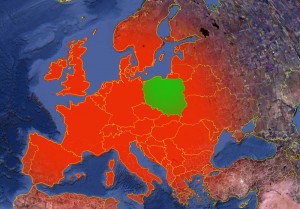

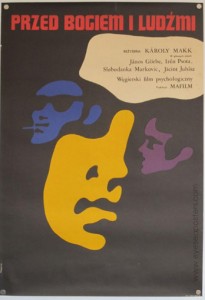
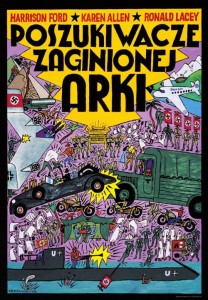

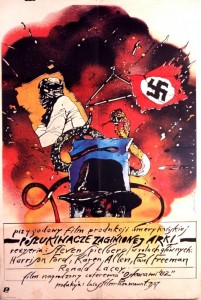



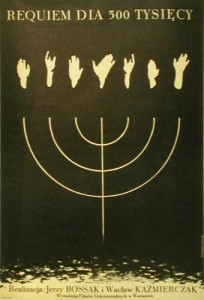
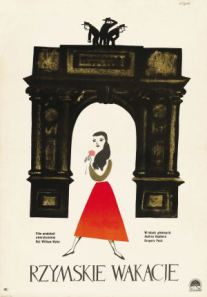

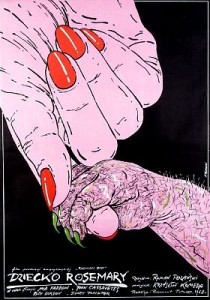
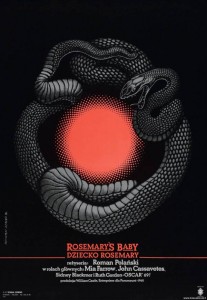
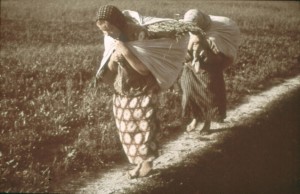
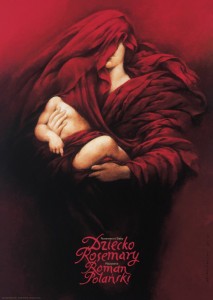

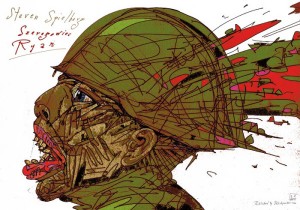
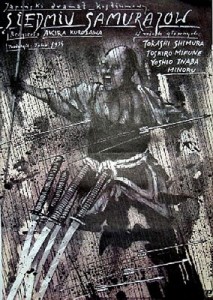

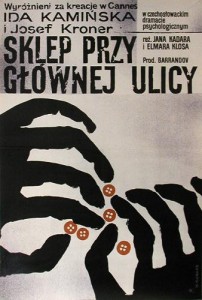
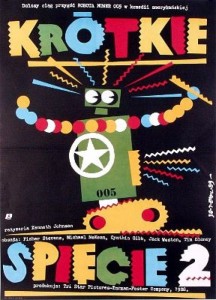
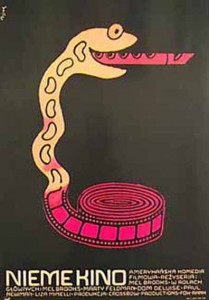

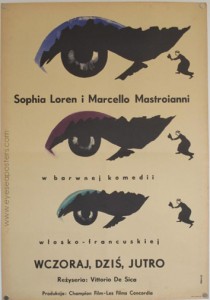
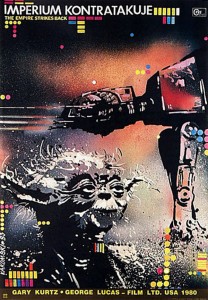

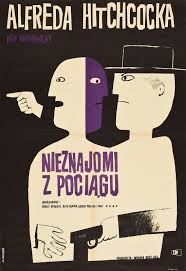
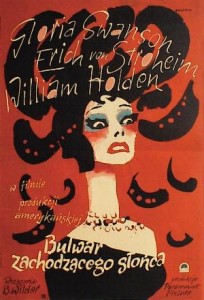

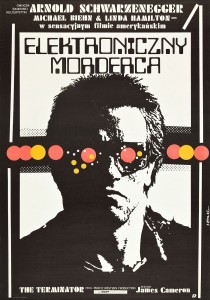
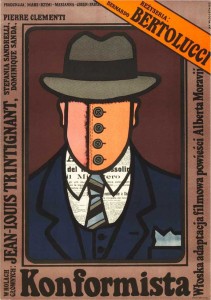

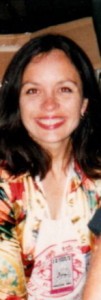

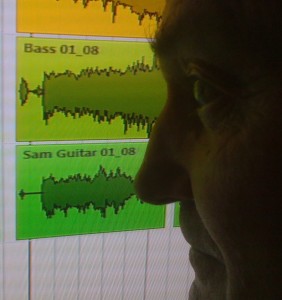








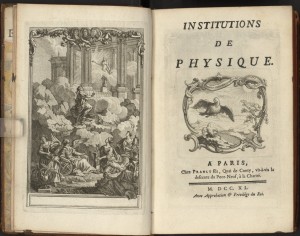

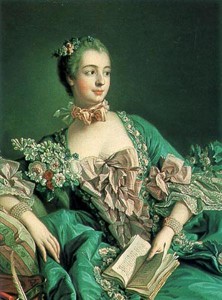




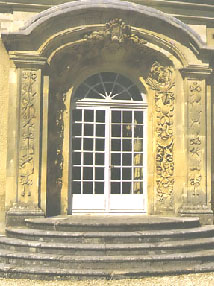

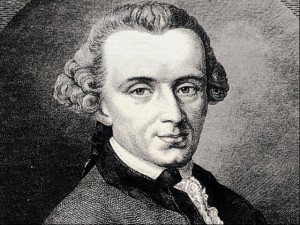

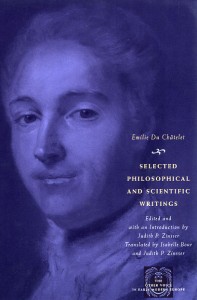
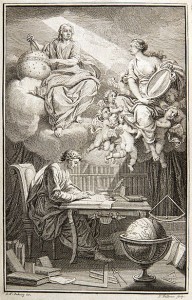
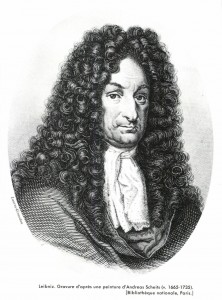
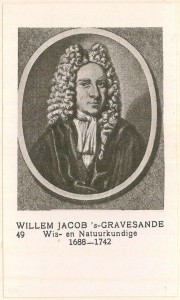
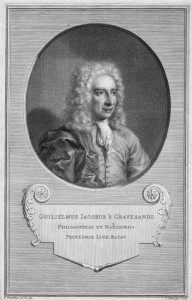
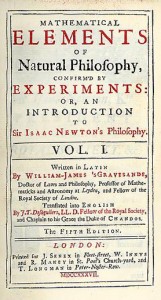
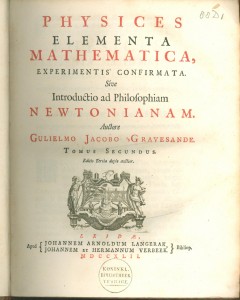

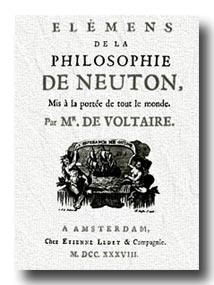
 , where
, where  is the kinetic energy of an object,
is the kinetic energy of an object,  its mass and
its mass and  its velocity.
its velocity. multiplier in Einstein’s mass-energy formula, and indeed
multiplier in Einstein’s mass-energy formula, and indeed  is the first term in the binomial expansion of the relativistic kinetic energy expression.
is the first term in the binomial expansion of the relativistic kinetic energy expression.